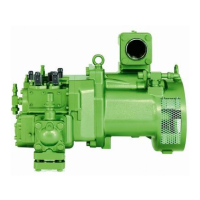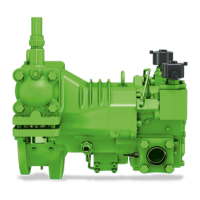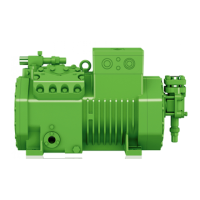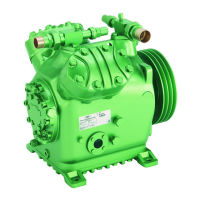16 ESB-130-3 RUS
ST-130-2
2
2 Functions
The OLC-D1-S can monitor either the
minimum or the maximum oil level,
depending on its mounting position
and incorporation into the safety
chain. If the minimum and the maxi-
mum oil level should be monitored,
two OLC-D1-S devices must be
installed.
2.1 Monitoring of the minimum
level
Lock out
The compressor is shut off, if the
prism sticks out of the oil longer than
the delay time specified by the circuit.
The OLC-D1-S then opens the output
contact and the circuit locks out elec-
tronically: The control voltage to the
compressor contactor is interrupted.
The red LED at the face side of the
opto-electronic unit lights up (figure 1)
as well as the signal lamp H4.
Reset
The circuit can be manually reset by
pressing the reset button. This reset
button (S4) has to be mounted into
the swich board. (Connection see
sche matic wiring diagram.)
2 Fonctionnement
Le OLC-D1-S peut contrôler soit le
niveau d'huile minimal soit le niveau
d'huile maximal, dépendant de la position
de montage et de l'intégration dans la
chaîne de sécurité. Pour surveiller le
niveau d'huile minimal et maximal en
même temps, deux OLC-D1-S doivent
être installés.
2.1 Contrôle du niveau d'huile minimal
Verrouiller
Le compresseur est arrêté des lors que le
temps pendant lequel le cône de verre
dépasse le niveau d'huile est supérieur à
la la temporisation prédéfinie par le
réglage.
Le OLC-D1-S ouvre alors le contact de
sortie et le circuit se verrouille électroni-
quement: la tension de commande du
con tacteur du compresseur est alors
coupée. La LED rouge sur le côté frontal
de l'unité opto-électronique s'allume (figu-
re 1) et ainsi que la lampe H4.
Déverrouiller
Le circuit peut être remis manuellement
en fonctionnement par la touche de reset.
Cette touche (S4) devra être montée
dans l'armoire électrique. (Raccordement
voir schéma de principe.)
2 Funktionen
Das OLC-D1-S kann entweder das
mini male oder das maximale Ölnive au
über wachen, je nach Montage-Posi ti -
on und Einbettung in die Sicher heits -
kette. Falls sowohl das mini male wie
das maximale Ölnive au über wacht
werden soll, müssen zwei OLC-D1-S
installiert werden.
2.1 Minimale Ölniveau-Überwa-
chung
Verriegeln
Der Verdichter wird abgeschaltet,
wenn der Glas-Kegel länger als die
durch die Schaltung vorgegebene Ver -
zöge rungs zeit aus dem Öl herausragt.
Das OLC-D1-S öffnet dann den Aus -
gangs kon takt und die Schaltung ver-
riegelt elektronisch: Die Steuerspan -
nung zum Verdich ter schütz wird unter-
brochen. Die rote LED auf der Stirn -
seite der opto-elektronischen Ein heit
(Abb. 1) und die Signallampe H4
leuchten.
Entriegeln
Die Schaltung kann über eine Reset-
Taste manuell zurück gesetzt werden.
Diese Reset-Taste (S4) muss im
Schalt schrank montiert werden.
(Anschluss siehe Prinzipschaltbild.)
Abb. 1 Abmessungen und Aufbau Fig. 1 Dimensions and design
Fig. 1 Dimensions et construction
1 Prisma-Einheit
2 Glas-Kegel
3 Dichtung
4 Opto-elektronische Einheit "OLC-D1"
(360° drehbar)
5 Anschlusskabel
6 Schraubkappe
1 Prism unit
2 Glass cone
3 Gasket
4 Opto-electronic unit "OLC-D1"
(360° revolving)
5 Connecting cable
6 Screwing cap
1 Unité prisme
2 Cône en verre
3 Joint
4 Composant opto-électronique "OLC-D1"
(mobile sur 360°)
5 Câble de raccordement
6 Chapeau à visser
4.6 Ölsumpfheizung(Option)
gewährleistet die Schmierfähigkeit
des Öls auch nach längeren Still-
standszeiten. Sie verhindert stärkere
Kältemittel-Anreicherung im Öl und
damit Viskositätsminderung.
Die Ölsumpfheizung muss im Still-
stand des Verdichters betrieben
werden bei
• Außen-AufstellungdesVerdichters
• langenStillstandszeiten
• großerKältemittel-Füllmenge
• GefahrvonKältemittel-
Kondensation in den Verdichter
5 InBetriebnehmen
Der Verdichter ist ab Werk sorgfältig
getrocknet, auf Dichtheit geprüft und
mit Schutzgas (N
2
) befüllt.
Achtung!
Druckfestigkeit und Dichtheit
der gesamten Anlage bevorzugt
mit getrockneten Stickstoff (N
2
)
prüfen.
Bei Verwendung von getrockneter
Luft, Verdichter nicht einbeziehen.
Gefahr!
Verdichter darf keinesfalls mit
Sauerstoff oder anderen tech-
nischen Gasen abgepresst
werden!
!
Warnung!
Dem Prüfmedium (N
2
oder Luft)
keinesfalls Kältemittel beimischen
– z. B. als Leck-Indikator.
Kritische Verschiebung der Kälte-
mittel-Zündgrenze bei Überdruck
möglich!
Umweltbelastung bei Leckage
und beim Abblasen!
4.6 Crankcaseheater(option)
ensures the lubricity of the oil even
after long standstill periods. It pre-
vents increased refrigerant solution in
the oil and therefore a reduction of the
viscosity.
The crankcase heater must be
energized during standstill for
• outdoorinstallationofthe
compressor
• longshut-offperiods
• highrefrigerantcharge
• dangerofrefrigerantcondensation
into the compressor
5 Commissioning
The compressor is already thoroughly
dehydrated, tested for leaks and
under pressure with holding charge
(N
2
).
Attention!
Test the strength pressure and
the tightness of the entire plant
preferably with dry nitrogen (N
2
).
Compressor must not be
included when using dried air.
Danger!
By no means the compressor
may be pressure tested with
oxygen or other industrial
gases!
!
Warning!
Never add refrigerant to the
test gas (N
2
or air) – e. g. as leak
indicator.
Critical shift of the refrigerant
ignition limit with high pressure
possible!
Environmental pollution with
leakage or when deflating!
4.6 Подогреватель картера (опция)
обеспечивает смазочную способность
масла даже во время длительных перио -
дов простоя. Он препятствует значител-
ьному растворению хладагента в масле и
тем самым снижению вязкости масла.
Подогреватель картера должен включа-
ться при выключении компрессора,
работающего в следующих условиях:
• компрессор установлен вне
помещения
• длительные периоды простоя
• большая заправка хладагентом
• существует опасность конденсации
хладагента в компрессоре
5 Ввод в эксплуатацию
Компрессор на заводе-изготовителе
тщательно высушен, испытан на
плотность и заполнен защитным газом
под давлением (N
2
).
Внимание!
Испытание на прочность и плотность
всей установки желательно
проводить сухим азотом (N
2
).
При использовании сухого воздуха
компрессор должен быть осечен от
системы.
Опасность!
Ни в коем случае не допускается
проводить испытания компрессора
кислородом или другими
промышленными газами!
!
Предупреждение!
Никогда не добавляйте хладагент в
газ для испытания (N
2
или воздух) –
например, как индикатор утечек.
Может произойти опасное снижение
точки воспламенения хладагента
при высоком давлении!
Возможно загрязнение окружающей
среды при утечке во время
испытания контура или при откачке
испытательного газа!

